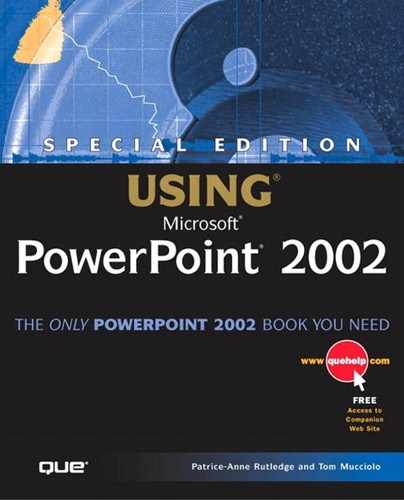Enabling Multiple Language Editing
On the Enabled Languages tab of the Microsoft Office Language Settings dialog box, you can enable PowerPoint (and other Office applications) to edit additional languages. From the Start menu, choose Programs, Microsoft Office Tools, Microsoft Office Language Settings to open this dialog box, shown in Figure B.3.
Figure B.3. Enabling a language activates special menus and dialog boxes related to it.

Can't find the Microsoft Office Language Settings dialog box? See the “Troubleshooting” section at the end of the appendix.
Select the language in which you want to edit and click the Add button to add it to the Enabled Languages box. If you want to remove a language, select it in the Enabled Languages box and click the Remove button. When you click OK, additional features and commands are installed based on your language choices.
For example, if you enable editing in Japanese, new menu commands appear in PowerPoint such as Format, Line Break, which opens the Asian Line Break dialog box, shown in Figure B.4.
Figure B.4. You can specify how to set up line breaks in Asian languages.

Can't find the menu options you need? See the “Troubleshooting” section at the end of the appendix.
This dialog box enables you to set line break rules for Asian languages.
Note
Office doesn't automatically enable all languages for editing, in order to avoid adding unnecessary options. You must manually enable editing in any language in which you create a PowerPoint presentation.
Even if you enable editing in certain languages—such as many Asian, right-to-left, and Central European languages—you must also meet certain system requirements before you can truly edit in those languages. For example, for some languages you need to use Windows NT 5 to gain full support.
In other cases, you can simply install the appropriate keyboard layout to edit in a certain language. To do this, choose Settings, Control Panel from the Windows Start menu and double-click the Text Input Settings icon in the Control Panel dialog box. Figure B.5 shows the Text Input Settings dialog box, where you can set keyboard and other language-related input preferences.
Figure B.5. Adding keyboard layouts makes it easier to work in another language.

Note
If you want to change the language of the user interface and online help, you need the Microsoft Office XP Multilingual User Interface Pack, which comes on a separate CD. If you've used a previous version of Office and are looking for the User Interface tab on the Microsoft Office Language Settings dialog box, you need to install this pack to view the tab. The MUI Pack includes translations for the user interface, online help, wizards, and templates, as well as proofing tools for spelling and grammar checks.
